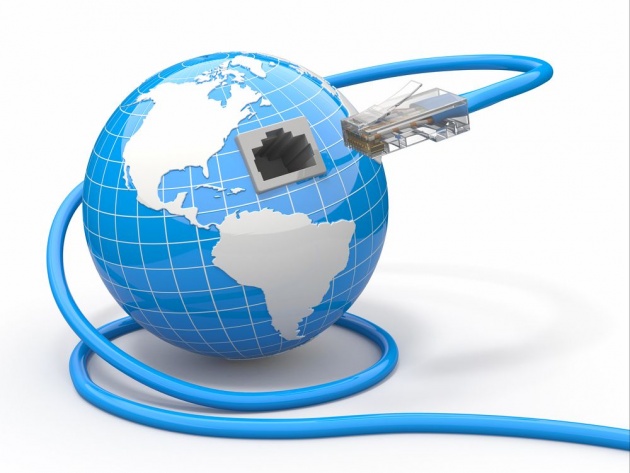Internet
The Internet is the global system of interconnected mainframe, personal, and wireless computer networks that use the Internet protocol suite (TCP/IP) to link billions of devices worldwide. It is a network of networks that consists of millions of private, public, academic, business, and government networks of local to global scope, linked by a broad array of electronic, wireless, and optical networking technologies. The Internet carries an extensive range of information resources and services, such as the inter-linked hypertext documents and applications of the World Wide Web (WWW), electronic mail, Usenet newsgroups, telephony, and peer-to-peer networks for file sharing.
Although the Internet protocol suite has been used by academia and the military industrial complex since the early 1980s, rapid adoption of its use was driven by events of the late 1980s and 1990s such as more powerful and affordable computers, the advent of fiber optics, the popularization of HTTP and the Web browser, and a push towards opening the technology to commerce. Internet use grew rapidly in the West from the mid-1990s and from the late 1990s in the developing world. In the 20 years since 1995, Internet use has grown 100-times to reach over one third of the world population,[1][2] leading to its services and technologies being incorporated into virtually every aspect of contemporary life. The impact of the Internet has been so immense that it has been referred to as the "8th continent".[3][4]
The origins of the Internet date back to research and development commissioned by the United States government, the United Kingdom government and the government of France in the 1960s to build robust, fault-tolerant communication via computer networks.[5][6][7][8] This work led to the primary precursor networks: the ARPANET, in the United States, the Mark 1 NPL network in the United Kingdom and CYCLADES in France.[9] The interconnection of regional academic networks in the 1980s marks the beginning of the transition to the modern Internet.[10] From the late 1980s onward, the network experienced sustained exponential growth as generations of institutional,personal, and mobile computers were connected to it.
Most traditional communications media, including telephony and television, are being reshaped or redefined by the Internet, giving birth to new services such as Internet telephony and Internet television. Newspaper, book, and other print publishing are adapting to website technology, or are reshaped into blogging and web feeds. The entertainment industry was initially the fastest growing segment on the Internet.[citation needed] The Internet has enabled and accelerated new forms of personal interactions through instant messaging, Internet forums, and social networking. Online shopping has grown exponentially both for major retailers and small artisans and traders. Business-to-business and financial services on the Internet affect supply chains across entire industries.
The Internet has no centralized governance in either technological implementation or policies for access and usage; each constituent network sets its own policies.[11] Only the overreaching definitions of the two principal name spaces in the Internet, the Internet Protocol address space and the Domain Name System (DNS), are directed by a maintainer organization, the Internet Corporation for Assigned Names and Numbers (ICANN). The technical underpinning and standardization of the core protocols are an activity of the Internet Engineering Task Force (IETF), a non-profit organization of loosely affiliated international participants that anyone may associate with by contributing technical expertise.[12]
History
Main articles: History of the Internet and History of the World Wide Web
Research into packet switching started in the early 1960s and packet switched networks such as Mark I at NPL in the UK,[19] ARPANET, CYCLADES,[20][21] Merit Network,[22] Tymnet, and Telenet, were developed in the late 1960s and early 1970s using a variety of protocols. The ARPANET in particular led to the development of protocols for internetworking, where multiple separate networks could be joined together into a network of networks.[23]
The first two nodes of what would become the ARPANET were interconnected between Leonard Kleinrock's Network Measurement Center at the University of California, Los Angeles (UCLA) Henry Samueli School of Engineering and Applied Science and Douglas Engelbart's NLS system at SRI International (SRI) in Menlo Park, California, on 29 October 1969.[24] The third site on the ARPANET was the Culler-Fried Interactive Mathematics Center at the University of California, Santa Barbara, and the fourth was the University of Utah Graphics Department. In an early sign of future growth, there were already fifteen sites connected to the young ARPANET by the end of 1971.[25][26] These early years were documented in the 1972 film Computer Networks: The Heralds of Resource Sharing.
Early international collaborations on the ARPANET were rare. European developers were concerned with developing the X.25 networks.[27] Notable exceptions were the Norwegian Seismic Array (NORSAR) in June 1973, followed in 1973 by Sweden with satellite links to the Tanum Earth Station and Peter T. Kirstein's research group in the United Kingdom, initially at the Institute of Computer Science, University of London and later at University College London.[28][29][30]
In December 1974, RFC 675 – Specification of Internet Transmission Control Program, by Vinton Cerf, Yogen Dalal, and Carl Sunshine, used the term internet as a shorthand for internetworking and later RFCsrepeat this use.[31] Access to the ARPANET was expanded in 1981 when the National Science Foundation (NSF) funded the Computer Science Network (CSNET). In 1982, the Internet Protocol Suite (TCP/IP) was standardized, which permitted worldwide proliferation of interconnected networks.
T3 NSFNET Backbone, c. 1992.
TCP/IP network access expanded again in 1986 when the National Science Foundation Network (NSFNET) provided access to supercomputer sites in the United States from research and education organizations, first at 56 kbit/s and later at 1.5 Mbit/s and 45 Mbit/s.[32] Commercial Internet service providers (ISPs) began to emerge in the late 1980s and early 1990s. The ARPANET was decommissioned in 1990. The Internet was fully commercialized in the U.S. by 1995 when NSFNET was decommissioned, removing the last restrictions on the use of the Internet to carry commercial traffic.[33] The Internet rapidly expanded in Europe and Australia in the mid to late 1980s[34][35] and to Asia in the late 1980s and early 1990s.[36]
The beginning of dedicated transatlantic communication between the NSFNET and networks in Europe began a low-speed satellite relay between Princeton University and Stockholm, Sweden in December 1988.[37] Although other network protocols such as UUCP had global reach well before this time, this marked the beginning of the "Internet proper" as an intercontinental network.
Slightly over a year later in March 1990, the first high-speed T1 (1.5 Mbit/s) link between the NSFNET and Europe was installed between Cornell University andCERN, allowing much more robust communications than were capable with satellites.[38] Six months later Tim Berners-Lee would begin writing WorldWideWeb, the first web browser after two years of lobbying CERN management. By Christmas 1990, Berners-Lee had built all the tools necessary for a working Web: theHyperText Transfer Protocol (HTTP) 0.9,[39] the HyperText Markup Language (HTML), the first Web browser (which was also a HTML editor and could access Usenet newsgroups and FTP files), the first HTTPserver software (later known as CERN httpd), the first web server (info.cern.ch), and the first Web pages that described the project itself.



